
Animals and vegetation This page is revised on the 1 August 1999

Flora and fauna in Oman is of course not as rich as in a tropical rain forest. But there is plenty to see ......

The corner of the Arabic peninsula is used by the big green turtle as nesting spot. The
'spot' covers 40 km of the cost where they lay their eggs. And they come again and again.
A turtle can be up to 150 years old. The season for the egg laying is in June-July during
the monsoon. In this period the weather fits the turtles perfectly. Very windy, humid and
rough. But that makes it possible for the turtles to work undisturbed by humans and other
animals. Both the locals, the seagulls and the foxes love eating the turtle eggs. The
turtles countermove is to arrive when the weather is most nasty. Well, in fact they come
at this time of the year because the sand has the right consistency, because of the
humidity, for burying the characteristic ½ metre deep holes with vertical sides in which
the turtle lays its eggs.


Sometimes they end up at the rocks or cliffs and can't find their way.
In a good night (i.e. at new moon when it is completely dark) there are approximately
4-700 turtles on that little piece of a beach to which the public is allowed to enter. The
other 38 km beach are prohibited area for the public, and the Ministry of Turtles is
guarding the beaches and the turtles. At full moon the number of turtles is reduced to
approximately 100. This huge number of turtles results in loss of eggs as they partly dig
out each others eggs, when they try to bury their own eggs. There is simply not enough
space for all these turtles. Each female lays approximately 100 eggs. They work during the
night, but some of them arrive on the beach so late in the night that they haven't
finished their work before sunrise. At this time of the day there is opportunity for
watching and making photos. The whole process from the turtle arrives at the beach until
she swims away again takes between 1 and 1½ hour.
After 2 months the small baby turtles come out and start immediately their fight for
survival. Only 1 out of 1000 becomes an adult turtle. The other 999 babies are being eaten
by seagulls and other animals in the sea while they are small.


First the lady turtle digs out the hole with the smaller flippers at the rear end, then
she lays the eggs and finally she throws, with the bigger flippers at the front, sand over
the hole containing the eggs. This process creates a crater (approximately at the position
of the head), which often but wrongly is taken for being the spot with the eggs. But that
is not the case. The eggs are positioned approximately ½ to 1 metre from the crater. The
foxes are cheated by this - if it wasn't for the fact that there are eggs all over, so
that they just have to start digging somewhere and soon they will find some eggs.

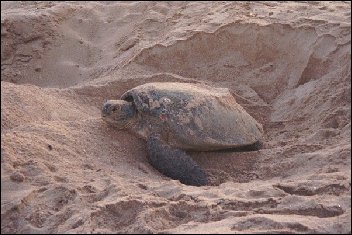
After this exhausting deed is about to get back to the rescuing water.
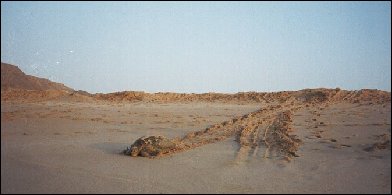




Never put a turtle on its back. It dies from it.

Good bye and see you .....
Other strange animals is e.g. this blue lizard (and it was not freezing):

Or a strange tree runner:

Bees are popular because of the honey. The picture does not show the bees, therefore it
shows how pretty places are being chosen for the beehives. The beehives are in this case
created out of hollow datepalms:

Donkeys:

The donkeys have previously been used as trucks. But their role as utility animal is soon over. I have in a few places seen how the donkey still has been used for transportation. It is mainly in the mountains the donkeys are to be found. Now, as they have become redundant they live wild. Nobody eats them.

Goats still play an important role in the society. For meat and for the milk. But.....
Previously as the humans were a part of the natural balance between bushes, trees, humans,
goats etc. there was a number of goats what the balance permitted. Now the humans have
taken off from this balance and have started a huge growth in their number. More people.
And to make a long story short: If there is no other possibility in the village, then it
is always possible to become a herdsman. More herdsmen and therefore more goats. The
number of goats has grown explosively, which according to biologists is a disaster,
because the goats are brutal to bushes and the roots of trees. They kick out roots and eat
everything. The bushes and the trees suffer under the increasing number of goats.
Apart from that, they taste delicious.


Yes, it is a goat which has learned to eat directly from the tree.

or the so-called 'climbing goat'.....
Except from this, the dominating animal is of course the camel (actually the dromedary,
but here it is called camel). They are being used as food ('beef cattle') for milk and as
investment. Their roll as means of transportation is over. Wild camels do hardly exist.
They all belong to somebody. They live quite free in the desert, but return normally back
home in the evening.


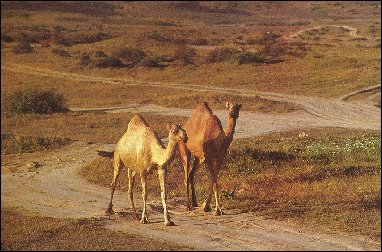
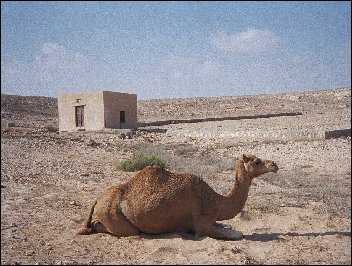

Two lonesome camels on their way in the desert.

A hunter and his prey.

This is the only time I have ever seen somebody actually riding a camel for the purpose of
transportation.
Scorpions are there a lot of:



Huge amounts of frogs:


Flamingos:

Ghost crabs
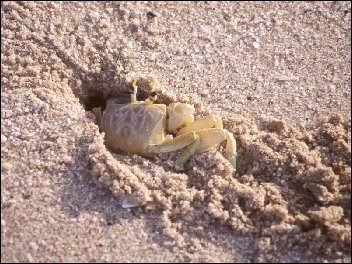
which look unsavoury because of their prominent eyes and their transparent look. They are
even fluorescent in the night. When they sit on the beach and they shortly have been
dipped into the seawater then they lighten up. The whole beach can be full of them
(approximately 10 crabs per square metre) (which says something on a kilometre long
beach).

Flowers and plants are there in thousands. These flowers below are from the pomegranate
tree.


Dates on a datepalm ready for harvesting. One datepalm carries 20 - 50 kg per year. The
season is between June and October, depending on which sort. There are several hundred
sorts. The taste is quite different from sort to sort. Normally four or five datepalms can
keep one family with "food" for one year. (See also: Villages).
Walnuts. Up here in 1700 metres above sea level they get enough water and it is not too
hot. The walnut trees are the big green trees in the bottom of the wadi:
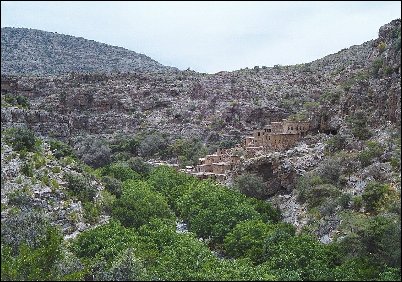

Almond tree.
What is also seen here is the mangrove:




Very small but presumably very old trees are to be seen in the desert:


Trees with small, beautiful flowers and big thorns.

Giant trees. This one is on top of Jabal Akhdar in the altitude of 2400 metres. In the
Alps there not even be grass left.
A little lonesome tree on flat rock (in 2000 metres - I don't understand it).

Big trees are also to be seen, even in the most remote and dry areas. But, as they
actually live there means that there must be water not so far away:


The Frankincense tree is an Omani speciality. It is from this tree that the from the Bible well known myrrh comes. It is the resin from the tree, which is drawn off, dried and burned. Well, not exactly burned but put on to live coal and then it releases the nicest odour. The resin is still used as basis for most natural perfumes (the non-artificial ones). To the Frankincense-odour is then added additional smells from other sources.
The Frankincense tree is growing in a small area in the southern part of Oman (as well
as in a part of Somalia). In those two places an extraordinary climate rules, which is not
found in any other place of the world. (It has something to do with the shape of the
mountains, the monsoon and the soil). On the satellite image are the fertile areas around
Salalah visible as red coloured areas. The rest of the area is as barren as it looks on
the image; dead desert. The distance from the coast up to the border to Saudi-Arabia (the
upper white line) is approximately 270 km.

The tree itself is ugly, but rare. The Frankincense was an extremely valuable and
expensive item; just think of the tree wise men who brought gold, incense and myrrh. It
grows wild in the area.



The little bush to the left is a Frankincense tree.